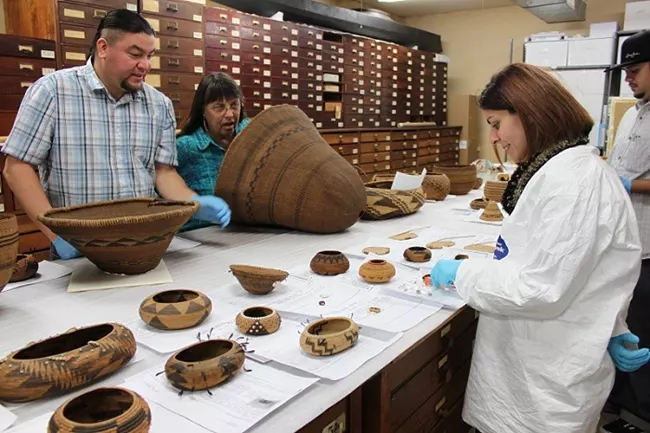First, we’d like to start with a land acknowledgement for Tufts University that we are grateful to borrow from an article in the Tufts Daily:
Tufts University’s Medford campus is located on Wôpanâak (Wampanoag) and Massachusett traditional territory. Tufts’ Walnut Hill was once one of the hills in a slave-holding estate called Ten Hills Plantation. Both Africans and Native Americans were enslaved in the colony of Massachusetts, and trade in Native American and African laborers made Massachusetts a driving force in the Atlantic slave trade.
Op-Ed: Acknowledging our settler-colonial present, the Tufts Daily
Last year, in honor of Indigenous Peoples’ Day, Tufts Museum Studies Blog editor Danielle Bennett shared a list of articles covering efforts to decolonize museums around the world. This year, we’re sharing events happening at Boston-area museums, planned jointly with indigenous educators, artists, and leaders, that celebrate native history and culture.
Monday, October 14, 2019
10:00 am–5:00 pm
Features: free admission, special events
Enjoy free admission and special events at the MFA for Indigenous Peoples’ Day—and the Fenway Alliance’s 18th annual Opening Our Doors Day. Indigenous Peoples’ Day recognizes and celebrates the heritage of Native Americans and the histories of their nations and communities. Enjoy music and dance, take a tour of our Native North American Art Gallery and respond to our collection, and drop in on family art-making activities and artist demonstrations.
Co-created and presented in partnership with Akomawt Educational Initiative and Jonathan James-Perry, Tribal Citizen of the Aquinnah Wampanoag Nation.
Founded in 1870, the Museum of Fine Arts, Boston, stands on the historic homelands of the Massachusett people, a site which has long served as a place of meeting and exchange among different nations.
Cost: free with free admission
Monday, October 14, 2019
10:00 am–4:00 pm
Also offered as part of The Fenway Alliance’s Opening Our Doors Day.
This Indigenous Peoples’ Day, the Gardner Museum is honored to collaborate with choreographer and Neighborhood Salon Luminary Marsha Parrilla of Danza Orgánica to present local Indigenous artists from the Massachusett, Nipmuc, Mashpee Wampanoag, and Aquinnah Wampanoag tribes.
The theme for the day is “Abundant Voices,” emphasizing the necessary perspectives and incredible work of these creative leaders. Enjoy hands-on art making, interactive performance, storytelling, a special performance from Gardner Museum Choreographers in Residence All Ready with local youth performers and more.
Explore additional hands-on activities and performances organized by The Fenway Alliance throughout the day across the street from the Gardner Museum in beautiful Evans Way Park.
Cost: free with free admission on a first-come, first-served basis
Saturday, October 12–Monday, October 14, 2019
9:00 am-5:00 pm
In a program marking Cambridge’s Indigenous People’s Day–celebrated as the federal holiday Columbus Day–eight Native American poets may be heard reading their work in the galleries. Enrich your museum visit by listening to an evocative recorded playlist of contemporary poems by Native American authors. Wander freely across the first-floor galleries to see where the poems take you and expand your understanding of Native arts and cultures. The poems, drawn from a powerful recent anthology, New Poets of Native Nations (edited by Heid E. Erdrich; Graywolf Press) celebrate Native poets first published in the twenty-first century. Hear the exhibits “come into voice” and experience the museum in a new way. Borrow a free audio player with regular museum admission.
Jointly sponsored with the Harvard University Native American Program and the Woodberry Poetry Room at Harvard University
Cost: free with regular admission
Saturday, October 12–Monday, October 14, 2019
9:00 am-5:00 pm
Long before Europeans arrived, the Wampanoag people were living in this area known as Patuxet. Join us as we acknowledge the indigenous groups that have called this place home and celebrate their traditions through song, dance, and craft.
Cost: free with regular admission
Monday, October 14, 2019
2:00–3:00 pm
Join Elizabeth James-Perry (Aquinnah Wampanoag) on Indigenous Peoples’ Day at Fruitlands Museum as she presents “Wampanoag Perspectives on the Land: Acknowledging Indigenous Space.” Elizabeth James-Perry (Aquinnah Wampanoag) is a multi-medium traditional and contemporary artist, with specialties in wampum shell carving and reviving natural dye techniques for her finger-woven sashes, bags, and baskets.
Cost: free with regular admission (space is limited – registration is requested)
Though the city of Boston and state of Massacusetts have yet to officially recognize Indigenous Peoples’ Day, we’re heartened to see that hasn’t stopped our cultural institutions. You can find other Boston-area happenings in this list from Cultural Survival. If you’re not in the Boston area, you can find Indigenous People’s Day events around the country in this list by Indian Country Today. Our guess (and hope) is that more museums near you may be celebrating and collaborating with indigenous voices tomorrow* – take a look for yourself!
*and next week, and next month, and next year, and so on – for many more days besides just tomorrow!



